Paul Gilster's Blog, page 88
April 8, 2019
Hayabusa2 Impactor Deployment
Putting a crater on an asteroid is no small matter, for it allows us to gather samples to further nail down the object’s composition. The Japan Aerospace Exploration Agency (JAXA) has achieved the feat on asteroid Ryugu using the Small Carry-on Impactor (SCI) carried by the Hayabusa2 spacecraft. Confirmation of the crater and details about its size will be forthcoming, but fortunately the spacecraft’s DCAM3 camera was able to record the event.
Following Hayabusa2 on Twitter (@haya2e_jaxa) is often the best way to keep up with operations at Ryugu (even as @OSIRISREx puts you inside that mission). The fact that we have two spacecraft in current operations around asteroids should be cause for continuing celebration. From the Hayabusa2 Twitter feed:
[SCI] The deployable camera, DCAM3, successfully photographed the ejector from when the SCI collided with Ryugu’s surface. This is the world’s first collision experiment with an asteroid! In the future, we will examine the crater formed and how the ejector dispersed. pic.twitter.com/eLm6ztM4VX
— HAYABUSA2@JAXA (@haya2e_jaxa) April 5, 2019
And with a closer look plus JAXA caption:

Image: This image captured by the camera separated from Hayabusa2 (DCAM3) shows ejection from Ryugu’s surface, which was caused by the collision of the SCI against Ryugu. Image taken at 11:36 a.m., April 5, 2019 (Indicated by the camera, Japan time). Credit: JAXA, Kobe University, Chiba Institute of Technology, The University of Occupational and Environmental Health, Kochi University, Aichi Toho University, The University of Aizu, and Tokyo University of Science.
The spacecraft protected itself before impact by moving to the other side of Ryugu to avoid any debris stirred by the collision. And while Hayabusa2 has already gathered one sample from the asteroid’s surface, the material gathered as a result of the impact should give scientists the opportunity to study what is below the surface, pristine material that dates back to the early days of the Solar System. Sample return is currently scheduled for late 2020.
As to the asteroid’s composition, the early data from Hayabusa2 have already proven useful. Says Seiji Sugita (University of Tokyo), author of a recent paper on the asteroid:
“Just a few months after we received the first data we have already made some tantalising discoveries. The primary one being the amount of water, or lack of it, Ryugu seems to possess. It’s far dryer than we expected, and given Ryugu is quite young (by asteroid standards) at around 100 million years old, this suggests its parent body was much largely devoid of water too.”
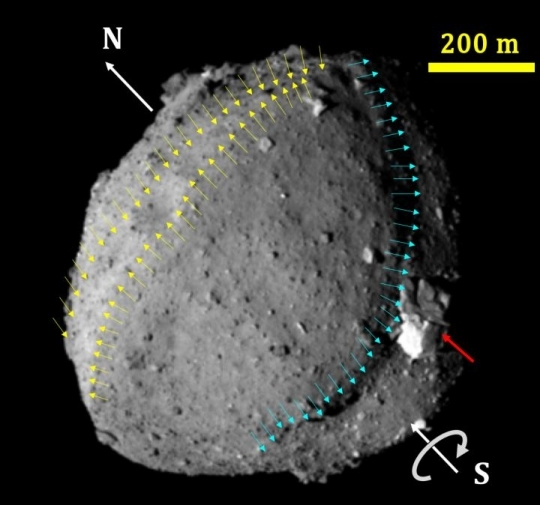
Image: Ryugu is a C-type asteroid — rich in carbon — about 900m wide. Credit: © 2019 Seiji Sugita et al., Science.
In a March 19 news conference, Sugita told an audience at the Lunar and Planetary Science Conference that Ryugu is now thought to be a fragment of one of two more distant asteroids, Eulalia or Polana. The breakup is thought to have occurred 700 million years ago. The best match in color — Ryugu is an extremely dark object — is with these two main belt asteroids, with the scientist pegging the likelihood of the relationship as high as 90 percent.
Both the visible-light camera and a near-infrared spectrometer aboard the spacecraft confirm the dearth of water, a significant result given that asteroids are thought to have supplied water to the early Earth, along with comets as well as the circumstellar disk of the system itself. Ryugu’s meager water stands in contrast to what OSIRIS-REx has found at asteroid Bennu. Although both asteroids appear similar, covered in boulders and presenting challenges to lander missions, Bennu contains considerably more water.
The paper examines a range of possibilities to explain this, but concludes that the general uniformity in color across Ryugu’s surface points to a parent asteroid that experienced internal heating caused by radioactive decay of Aluminium-26. As the authors note: “Internal heating can warm a large fraction of the volume of the parent body relatively uniformly, leaving a small volume of outer layer relatively cool.” The paper continues:
Although multiple scenarios for the evolution of Ryugu’s parent body remain viable, our comparison between Hayabusa2 remote-sensing data, meteoritic samples and asteroids leads us to prefer the scenario of parent-body partial dehydration due to internal heating. This scenario suggests that asteroids that accreted materials which condensed at ≤150 K (the H2O condensation temperature under typical solar nebula conditions) must have either formed early enough to contain high concentrations of radiogenic species, such as 26Al, or formed close to the Sun where they experienced other heating mechanisms). The degree of internal heating would constrain the location and/or timing of the snow line (i.e., the dividing line between H2O condensation and evaporation) in the early Solar System.
Thus the different traits of seemingly similar asteroids like Ryugu and Bennu offer plentiful ground for studying the astrophysical processes that shaped each. The paper is Sugita et al., “The geomorphology, color, and thermal properties of Ryugu: Implications for parent-body processes,” Science 19 March 2019 (abstract).






April 5, 2019
White Dwarf Debris Suggests a Common Destiny
An iron and nickel-rich planetesimal is apparently all that survives of a planet following the death of its star, SDSS J122859.93+104032.9. We are talking about an object in an orbit around a white dwarf so tight that it completes a revolution every two hours. Significantly, spectroscopic methods were used to make the identification, the first time a solid body has been found around a white dwarf with spectroscopy. Variations in emitted light were used to identify the gases generated by the planetesimal, with data from the Gran Telescopio Canarias in La Palma.
Lead author Christopher Manser (University of Warwick) notes the advantages of the method the team developed to study a white dwarf 400 light years away:
“Our discovery is only the second solid planetesimal found in a tight orbit around a white dwarf, with the previous one found because debris passing in front of the star blocked some of its light — that is the “transit method’’ widely used to discover exoplanets around Sun-like stars. To find such transits, the geometry under which we view them has to be very finely tuned, which means that each system observed for several hours mostly leads to nothing. The spectroscopic method we developed in this research can detect close-in planetesimals without the need for a specific alignment.”
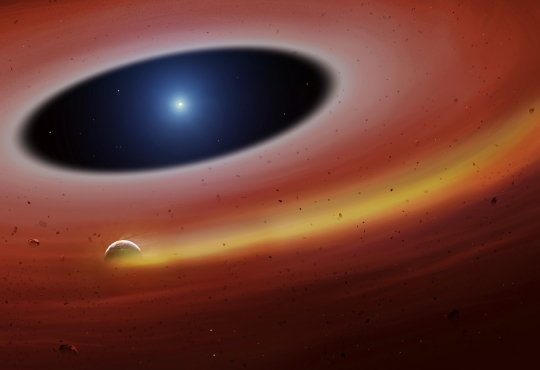
Image: A planetary fragment orbits the star SDSS J122859.93+104032.9, leaving a tail of gas in its wake. Credit & copyright: University of Warwick/Mark Garlick.
This is an extreme environment, the white dwarf in question being surrounded by a debris disk through which the object passes in its orbit. The star itself is about 70 percent of the mass of the Sun and, like all white dwarfs, this one — roughly the size of Earth — is quite dense, a survivor of the star’s red giant phase. An object moving this close to the white dwarf will be under extreme gravitational stress; the gravity of SDSS J122859.93+104032.9 is fully 100,000 times that of the Earth. The fact that the team could identify a planetesimal deep within the gravitational well indicates it must be an object of great density, probably made up of iron and nickel.
On where the object came from, the paper offers this intriguing possibility:
This object may be the differentiated iron core of a larger body that has been stripped of its crust and mantle by the tidal forces of the white dwarf. The outer layers of such a body would be less dense and would disrupt at greater semimajor axes and longer periods than those required for core disruption. This disrupted material would then form a disc of dusty debris around SDSS J1228+1040, leaving a stripped corelike planetesimal orbiting within it.
Manser’s colleague and co-author Boris Gaensicke adds if the assumption that we are dealing with a planetary core is correct, then the original body would have been at least hundreds of kilometers in diameter, because it is only at this size that planets begin to differentiate, with heavier elements sinking to form a metal core. It could, of course, have been much larger.
Thus the survival of a planetesimal here, actually orbiting within the original radius of its star, suggests a large object ultimately shredded by gravitational forces. We are glimpsing what our own Solar System may resemble in 5 to 6 billion years, when it will be a white dwarf orbited by the outer planets along with asteroids and comets. Our star’s expansion into a red giant will savage the inner system, perhaps leaving debris like what we see around SDSS J122859.93+104032.9. Bear in mind, too, that the vast majority of the stars known to host planets will end their lives as white dwarfs, so we are looking at a common destiny.
The debris disk of the white dwarf is rich in magnesium, iron, silicon and oxygen, and it is within that disk that the scientists found gas streaming from the evidently solid body. The object appears to be about a kilometer in size but could be as large as a few hundred kilometers in diameter. Whether it is the source of the gas or simply the cause of the gaseous ‘tail’ as it collides with debris in the disk is not yet known. Learning more will involve studying other debris disks similar to SDSS J122859.93+104032.9 (eight gaseous white dwarf debris discs are currently known), where the spectroscopic method will perhaps find other instances of planetesimals orbiting near or within the parent star’s debris disk.
The paper is Manser et al., “A Planetesimal Orbiting Within the Debris Disc Around a White Dwarf Star,” Science April 4 2019 (abstract).






April 4, 2019
HR 8799e: A New Level of Exoplanet Imaging
A method for enhanced exoplanet investigation takes center stage today as we look at the GRAVITY instrument, a near-infrared tool aided by adaptive optics that brings new precision to exoplanet imaging. In operation at the European Southern Observatory’s Very Large Telescope Interferometer (VLTI) at Paranal Observatory in Chile, GRAVITY works with the combined light of multiple telescopes to produce what would otherwise take a single telescope with a mirror diameter of 100 meters to equal. The early demonstrator target is exoplanet HR 8799e.
The method at work is interferometry, and here we are applying it to a ‘super Jupiter,’ more massive and much younger (at 30 million years) than any planet in our Solar System. The GRAVITY observations of this target mark the first time that optical interferometry has been used to study an exoplanet at this level of precision, producing a highly detailed spectrum. The planet is part of a 5-planet system some 130 light years away, all 5 of the planets being gas giants between 5 and 10 times the mass of Jupiter.
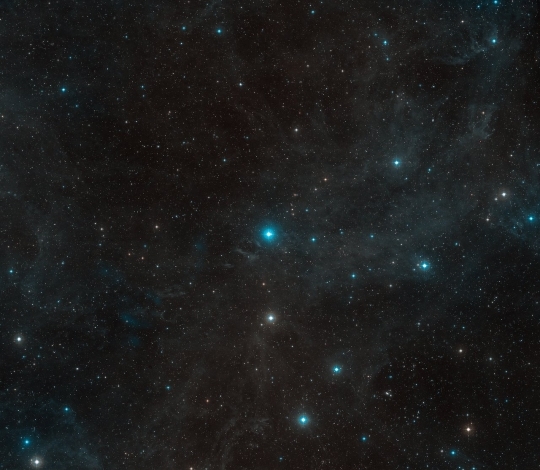
Image: This wide-field image shows the surroundings of the young star HR 8799 in the constellation of Pegasus. This picture was created from material forming part of the Digitized Sky Survey 2. Credit: ESO/Digitized Sky Survey 2. Acknowledgement: Davide de Martin.
The high resolution images that resulted from this work show what we can expect from optical interferometry going forward. We now know the distance between HR8799e and its star with 10 times the accuracy of previous estimates, which in turn helps to refine the planet’s orbit, one that appears to be slightly inclined compared to the orbital plane of its four companions.
That high-grade spectrum has spoken volumes about the composition of the planet’s atmosphere, says team leader Sylvestre Lacour (Observatoire de Paris and the Max Planck Institute for Extraterrestrial Physics):
“Our analysis showed that HR8799e has an atmosphere containing far more carbon monoxide than methane — something not expected from equilibrium chemistry. We can best explain this surprising result with high vertical winds within the atmosphere preventing the carbon monoxide from reacting with hydrogen to form methane.”
Also present here are clouds of iron and silicate dust, all suggestive of violent storms, as convection causes the dust to rise and then descend into the interior. We’re seeing a giant planet in its turbulent infancy. And what an impressive demonstration of interferometry’s ability to separate star and, in this case, a very close planet, with a result that the European Southern Observatory considers much cleaner than what could be achieved with a coronagraph that would mask out the light of the star.
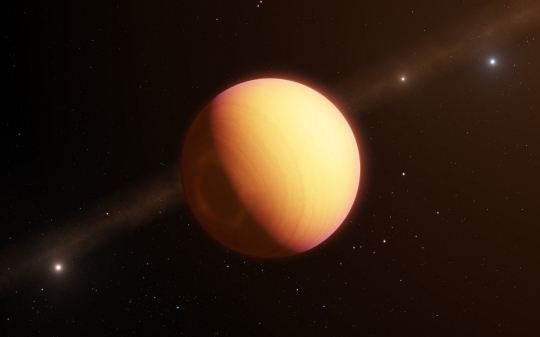
Image: Exoplanet HR 8799e has been analyzed spectroscopically separate from the parent star HR 8799 using the new technique (artistic impression). Credit: © ESO/Luis Calçada.
We’ll be using analyses of planetary atmospheres to look for biosignatures one day on cooler and more clement worlds. In the interim, astronomers plan to continue the investigation of the HR8799e system, allowing so complete an analysis of the planet’s orbit that it will be used to reveal the mutual gravitational interactions of the giant planets as well as the influence of the central star. That, in turn, takes us to accurate estimates of the planetary masses.
And these excerpts from the paper are notable. In the first, ‘Kmag’ refers to ‘K magnitude,’ the magnitude of the star about which the extrasolar planet orbits as viewed through a specific filter at near-infrared wavelengths, in this case between 2.0 and 2.4 μm. GRAVITY operates within the K band:
The interferometric technique brings unique possibilities to characterize exoplanets. With the technique described here, any planet with K ≾ 19, ∆Kmag ≾ 11, and separation ≿ 100 mas is, in theory, observable with GRAVITY. The numbers are still to be refined, but it would mean that GRAVITY could observe most of the known imaged planets, and maybe in the near future planets detected by radial velocity [italics mine].
And this:
…the idea that an interferometer can resolve the surface of exoplanets, giving radius and resolving clouds patchiness, is now becoming more plausible. However, it would require an interferometer with baselines on the order of 10 km. This could be a goal for ESO after ELT construction.
The paper is Lacour et al., “First direct detection of an exoplanet by optical interferometry,” in Astronomy and Astrophysics, Vol. 623 (March 2019), L11 (abstract / preprint).






April 3, 2019
Shaping the TESS Target List
Picking up on TESS (Transiting Exoplanet Survey Satellite), one of whose discoveries we examined yesterday, comes news of a document called the “TESS Habitable Zone Star Catalog.” The work of Cornell astronomers in collaboration with colleagues at Lehigh and Vanderbilt, the paper has just been published in Astrophysical Journal Letters (citation below), where we find 1,822 stars where TESS may find rocky terrestrial planets.
The listed 1,822 are nearby stars, bright, cool dwarfs, with temperatures roughly between 2,700 and 5,000 Kelvin, with a TESS magnitude brighter than 12 and reliable data from the Gaia Data Release 2 as to distance. Here TESS can detect 2 transits of planets that receive stellar irradiation similar to Earth’s, during the 2-year prime mission. 408 of these stars would allow TESS to detect transiting planets down to Earth size during one transit. The catalog is fine-tuned to the TESS instrumentation and mission parameters, the stars selected because they offer sufficient observing time to be able make these detections.
From the paper:
What distinguishes this catalog from previous work like HabCat (Turnbull & Tartar 2003), DASSC (Kaltenegger et al 2010) and CELESTA (Chandler, McDonald, & Kane 2016) is that the stars included here are specifically selected to have sufficient observation time by TESS for transit detection out to the Earth-equivalent orbital distance. We also use Gaia DR2 data, which allows us to exclude giant stars from the star sample and provides reliable distances for our full star sample. All the stars have been included in the TESS exoplanet Candidate Target List, ensuring that they will also have 2-minute cadence observation (provided they do not fall in TESS camera pixel gaps), providing a specific catalog for the TESS mission of stars where planets in the Habitable Zone can be detected by TESS. This data will be available to the community in the ongoing public TESS data releases.
In case you’re wondering, 137 stars in the catalog are within the continuous viewing zone of the James Webb Space Telescope, which will be able to observe them to characterize planetary atmospheres and search for biosignatures. Many more will be followed up after any TESS planet identifications by ground-based extremely large telescopes currently under construction.
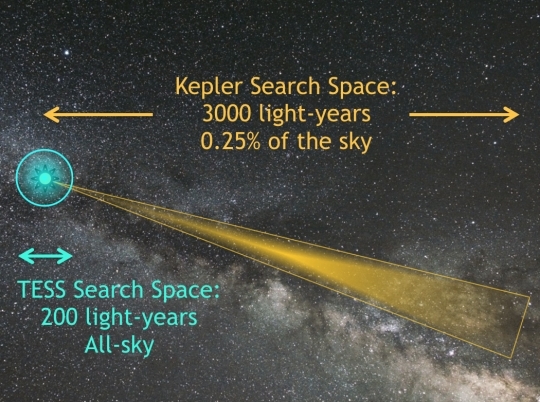
Image: The TESS search space compared to that of the Kepler Mission. Credit: Zach Berta-Thompson.
The idea, then, is to help us shape our target lists for TESS by pointing to the most likely places of discovery. Meanwhile, Elisa Quintana (NASA GSFC) has been thinking about planets we can’t yet detect but which may indeed be present, using Kepler data as massaged by a mathematical model that has implications for TESS and future mission datasets. The difference is that in Quintana’s case, these are systems where we already know planets exist. The question: What other planets might yet be found in the same systems?
After all, we have to wonder what our methods may have missed. The Kepler mission has led us to believe that most stars in the galaxy have planetary companions, but around even relatively close stars, we may be seeing a subset of what’s actually there. Using the transit method, which Kepler employed to such brilliant effect, we only see the planets that move across the face of the star as seen from Earth. There could be others in the same system that do not.
Think about how rare a transit of Venus is. Even from our vantage so close to the planet, we see Venus cross the Sun only in pairs of transits eight years apart, separated by gaps of over a century. Indeed, the last transit of Venus of the 21st Century has already taken place (5,6 June, 2012); we have to wait until December of 2117 for the next. The orbit of Venus is responsible for the rarity of the phenomenon; it’s inclined by 3.4° relative to the Earth’s orbit. Exoplanetary systems are presumably not immune to such variation.
Quintana has been working as mentor with an 18 year-old high school student named Ana Humphrey, who developed the model to predict possible planets in such systems. Out of Humphrey’s work, which has garnered a a $250,000 prize in the Regeneron Science Talent Search, we learn that there may be as many as 560 ‘hidden’ planets in exoplanet systems identified by Kepler. Says Humphrey:
“I was completely fascinated by this idea of finding new planets using mass, based on data that we already had. I think it just shows that even if your data collection is complete, there’s always new questions that can be asked and can be answered.”
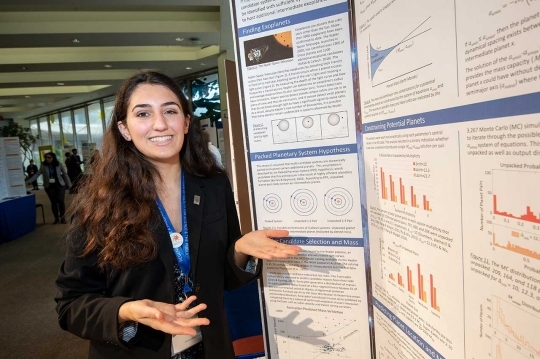
Image: Ana Humphrey won a $250,000 prize for calculating the potential for finding more planets outside our solar system. Credit: NASA GSFC.
Indeed, as Quintana points out, systems like Kepler-186 show a large gap that exists between the four planets close in to the star and the outer planet. Another world the size of Earth could be there on an orbit inclined enough that we would not see it. Extend this over the range of multi-planet systems found thus far and there is ample room for additional discovery. Humphrey’s model manipulates the possible space between the hypothetical planet and its neighbors, to see what worlds of varying mass could be present without disrupting their orbits.
This could come in handy for TESS, which as we saw yesterday, is already producing planetary discoveries like TOI-197. Applying the new model to the exoplanet database being assembled by TESS would allow both it and future missions to predict systems in which hidden planets might be found. Such systems might then be studied both by transits and other methods.
In examining such questions, Quintana and Humphrey are simply extending a time-honored method of planetary discovery, one that led Johann Gottfried Galle, working with calculations from Urbain Le Verrier, to discover Neptune in 1846 (and yes, Neptune was observed before this but was not known to be a planet). The mathematical calculations that produced Neptune as planet captured the imagination of François Arago, who said that Le Verrier had discovered a planet “with the point of his pen.” Thus does one world grow out of another — it was data on Uranus and the irregularities of its orbit that led to our learning the true nature of Neptune.
Remarkably, Triton was discovered a mere 17 days after the discovery of Neptune, another case of data cascade. Applying the same concept to exoplanets has been a natural progression. We can actually see only a few such worlds through direct imaging. Fine-tuning our models to fit the methods and instruments at hand maximizes the opportunity to enlarge our catalog.
The paper is Kaltenegger et al., “TESS Habitable Zone Star Catalog,” Astrophysical Journal Letters Vol. 874, No. 1 (26 March 2019). Abstract / preprint.






April 2, 2019
TESS: A ‘Hot Saturn’ & Asteroseismology
It’s good to see TESS, the Transiting Exoplanet Survey Satellite, producing early results. We’re coming up on the one year anniversary of its launch last April 18, with the spacecraft’s four cameras doing month-long stares at 26 vertical strips of sky, beginning with the southern hemisphere. Two years of such scanning will produce coverage of 85 percent of the sky.
The focus on bright, nearby stars is a shift from the Kepler strategy. While both missions have dealt with planetary transits across the face of their star as seen from the spacecraft, TESS is going to be producing plenty of data for follow-ups, planets close enough that we can consider studying their atmospheres with future missions beginning with the James Webb Space Telescope. Kepler’s long stare was of distant stars in a specific region, the idea being to gain a statistical understanding of the prevalence of planets. TESS gets us closer to home.
Now we have TOI-197 (TOI stands for ‘TESS Object of Interest’), a planet close to the size of Saturn in a tight orbit of its star (about 14 days). Asteroseismology comes into play here, with astronomers from the TESS Asteroseismic Science Consortium (TASC) using stellar oscillations to make a call on the star’s age, about 5 billion years. The star turns out to be slightly larger than the Sun, a late subgiant / early red giant, while the candidate planet shows a radius 9 times that of Earth. It masses 60 Earths, and its density is 1/13th that of our own planet.
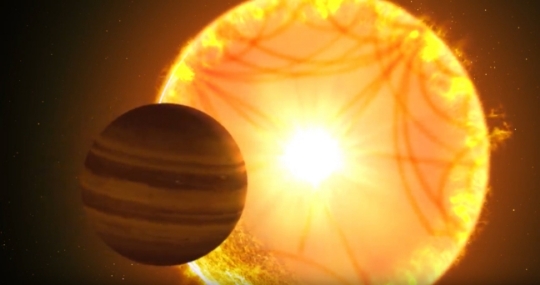
Image: A “hot Saturn” passes in front of its host star in this illustration. Astronomers who study stars used “starquakes” to characterize the star, which provided critical information about the planet. Credit: Gabriel Perez Diaz, Instituto de Astrofísica de Canarias.
Asteroseismologists examine seismic waves in stars (think of them as ‘starquakes’) that show up as changes in brightness, and offer useful clues about about radius, mass and age. TOI-197 turns out to be the first TESS planet for which the oscillations of the host star can be measured. It’s interesting to see, then, that in addition to the paper on TOI-197, we also have a new paper that will prove useful for TESS characterizations going forward. It’s a target list, prepared by TASC, that identifies some 25,000 stars that are both Sun-like and oscillating.
So the asteroseismology work with TESS data gets underway. Steve Kawaler (Iowa State University) notes the scope of the work:
“The thing that’s exciting is that TESS is the only game in town for awhile and the data are so good that we’re planning to try to do science we hadn’t thought about. Maybe we can also look at the very faint stars – the white dwarfs – that are my first love and represent the future of our sun and solar system.”
An interesting thought given shape by the TOI-197 findings that reveal TESS’ potential for asteroseismology. From the discovery paper:
TOI-197 provides a first glimpse at the strong potential of TESS to characterize exoplanets using asteroseismology. TOI-197.01 has one the most precisely characterized densities of known Saturn-sized planets to date, with an uncertainty of ∼ 15%. Thanks to asteroseismology the planet density uncertainty is dominated by measurements of the transit depth and the radial velocity amplitude, and thus can be expected to further decrease with continued transit observations and radial velocity follow-up, which is readily performed given the brightness (V=8) of the star. Ensemble studies of such precisely characterized planets orbiting oscillating subgiants can be expected to yield significant new insights on the effects of stellar evolution on exoplanets, complementing current intensive efforts to characterize planets orbiting dwarfs.
We also have in TOI-197 an addition to the list of close-in transiting worlds around evolved stars; i.e., stars that have begun their transition to red giant status. Worlds like this undergo what the paper calls ‘radius reinflation’ as the host star evolves up the red giant branch. According to the paper, TESS is expected to “detect oscillations in thousands of main-sequence, subgiant and early red-giant stars… and simulations predict that at least 100 of these will host transiting or non-transiting exoplanets.”
The papers are Schofield et al., “The Asteroseismic Target List for Solar-like Oscillators Observed in 2 minute Cadence with the Transiting Exoplanet Survey Satellite,” Astrophysical Journal Supplement Series Vol. 241, No. 1 (14 March 2019). Abstract; and Huber et al., “A Hot Saturn Orbiting an Oscillating Late Subgiant Discovered by TESS,” accepted at the Astronomical Journal (preprint).






April 1, 2019
A Slow Motion Asteroid Breakup
The odd lightcurve of the star known as VVV-WIT-07, discussed here last Friday, reminds us that even as we start seeing such signatures, we are tuning up our ability to find others. It’s a point that bears repeating from the paper on this work:
…surveys like ours, apart of course from its irregular cadence, may perhaps not have found objects like WIT-VVV-07 more often primarily because they were not looking specifically for this kind of variability.
The authors go on to say that next generation surveys like LSST (Large Synoptic Survey Telescope), now under construction, as well as space-based assets like the upcoming WFIRST and PLATO missions, will likely pin down further instances of unusual light curves.
It’s a point worth making again when we pivot to today’s discussion, on the asteroid known as (6478) Gault, a 4 kilometer-wide object currently some 344 million kilometers from the Sun. What we see here are two dusty tails reminiscent of a comet that are streaming behind Gault, an apparently gentle release of material that tells us the asteroid is gradually coming apart.
“We didn’t have to go to Gault,” explained Olivier Hainaut of the European Southern Observatory in Germany, a member of the Gault observing team. “We just had to look at the image of the streamers, and we can see all of the dust grains well-sorted by size. All the large grains (about the size of sand particles) are close to the object and the smallest grains (about the size of flour grains) are the farthest away because they are being pushed fastest by pressure from sunlight.”
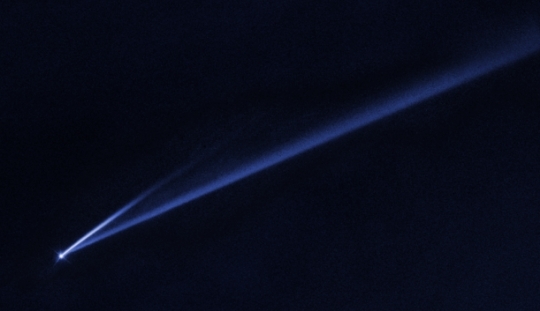
Image: This Hubble Space Telescope image reveals the gradual self-destruction of an asteroid, whose ejected dusty material has formed two long, thin, comet-like tails. The longer tail stretches more than 800,000 kilometers (500,000 miles) and is roughly 4,800 kilometers (3,000 miles) wide. The shorter tail is about a quarter as long. The streamers will eventually disperse into space. Credit: NASA, ESA, K. Meech and J. Kleyna (University of Hawaii), and O. Hainaut (European Southern Observatory).
At work here is apparently the same YORP (Yarkovsky–O’Keefe–Radzievskii–Paddack) effect that seems to be gradually spinning up asteroid Bennu as examined by the OSIRIS-REx mission. You would think a collision between asteroids could produce the same visual effect, but observations with the Hubble Space Telescope, which took the above image, have shown no signs of any debris other than what we see in the two ‘tails.’
Scientists believe these will begin to fade within months as the dust is gradually dispersed. Their narrow shape is an indication that they were released in short bursts, a series of puffs that probably did not last more than a few days. Perhaps, as with WIT-VVV-07, we are looking at a phenomenon we’re soon to see more of, for enhanced survey efforts like Pan-STARRS (the Panoramic Survey Telescope and Rapid Response System at Haleakala Observatory, Hawaii) and ATLAS (Asteroid Terrestrial-impact Last Alert System, at Haleakala and Mauna Loa), are likely to find far more active asteroids than we’ve seen thus far. Both operations saw the Gault debris, ATLAS in early 2019 and Pan-STARRS in subsequent analysis of archival data.
Especially intriguing is the two-hour rotation period measured for Gault, which is about the critical speed at which a ‘rubble pile’ asteroid begins to break up. Jan Kleyna, lead author of the paper on this work, calls it “…the best smoking-gun example of a fast rotator right at the two-hour limit.” As to the YORP effect, it occurs when an asteroid is unevenly heated by incident sunlight, producing infrared radiation that carries off not only heat but momentum. The scientists studying Gault believe it could have been spinning up for more than 100 million years.
From the paper:
…dust emission is strongly suggestive of a rotation-induced event due to the YORP effect, as the object is spun-up by re-radiation forces until the apparent surface gravity is zero, triggering disruption or landslide events… releasing near-zero-velocity debris that is swept away by radiation pressure. Sudden and brief landslides are in accord with the abrupt dust releases described in §4. Because of the large mass of material released, it is likely that these landslides were significant, and that the equatorial velocity of the object is very close to the liberation velocity, i.e., that the surface material is tenuously held to the surface, with a proclivity to rearrange itself.
So we’re learning more about YORP and its potential for changing trajectories and causing surface disruption on asteroids, with missions to such objects as well as ever more refined distant observation. Keeping an eye on Gault for possible future events should tell us more, and help us determine just how rare such activity on the roughly 800,000 asteroids between Mars and Jupiter is. Current estimates are that similar asteroid events will occur about once a year.
The paper is Kleyna et al., “The Sporadic Activity of (6478) Gault: A YORP-driven event?,” accepted at Astrophysical Journal Letters (preprint).






March 28, 2019
Unusual Lightcurve of a ‘What Is This’ Star
VISTA (Visible and Infrared Survey Telescope for Astronomy) is a near-infrared instrument located at the European Southern Observatory’s Paranal site, and is by all accounts the world’s largest survey telescope, with extremely wide field of view and sensitive detectors. On the peak next to ESO’s Very Large Telescope (VLT), VISTA shares its exceptional viewing conditions using a 4.1-meter primary mirror and a three-tonne camera with 16 infrared detectors.
With its time devoted to six surveys ranging from complete southern sky coverage to small patches of sky looking for extremely faint objects, VISTA was bound to come up with interesting data, especially in the survey known as VVV, which stands for VISTA Variables in Via Láctea. Here, astronomers are homing in on regions that are obscured by dust in the bulge and southern Galactic disk, using pulsating RR Lyrae and Cepheid variables as distance indicators, with a focus on microlensing events, eclipsing binaries and pre-main sequence variable stars.
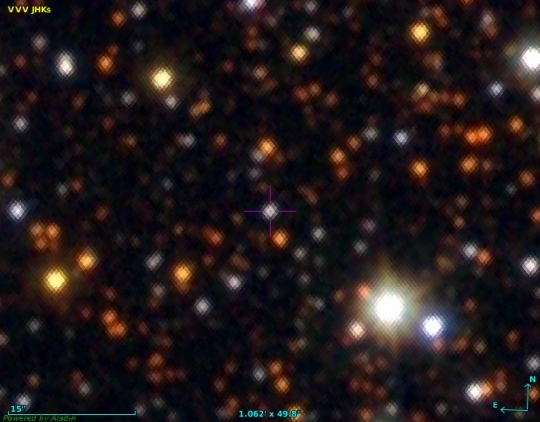
Image: VVV-WIT-07 in the centre of a star field. Credit: Saito et al.
This is fertile ground for discovery, but even so, the object known as VVV-WIT-07 is taking everyone a bit by surprise. We’re dealing with a star that reminds everyone of Boyajian’s Star (KIC 8462852), famed for its unusual dips in lightcurve. Were they signs of a Dyson Sphere under construction, or a natural phenomenon the likes of which we had never seen? Uneven rings of dust, dusty planetesimals or comets are still in contention. Now we have a star that is apparently even more extreme, one whose range in lightcurve variation is extraordinary. Viewed by the survey over a period of eight years, VVV-WIT-07 has been seem to dim first by a factor of 2, then by almost 80 percent. A week later, it was back to normal.
Here’s what the ESO blog had to say about the matter:
“The first observations showed nothing strange — simply a mild scatter in the brightness measurements, consistent with the observational uncertainties. However, in August–September 2011, just before the end of the observing season, the star dimmed by a factor of almost two! By June 2012, when we began re-observing it, the star’s brightness was nearly back to normal. But by mid-July, it had dimmed by almost 80%! Then it was back to its usual self in about a week. The data taken since then contain hints of additional drops in brightness, but nothing so dramatic.”
The WIT designation is fun — it stands for What Is This, and the VVV team is using it to describe any objects that do not apparently fit known classes of stellar variability. WIT may remind you of another appellation for Boyajian’s Star, which was the ‘WTF Star,’ its ambiguous acronym standing surely for ‘Where’s the Flux?’ Have a look at the lightcurve of VVV-WIT-07:
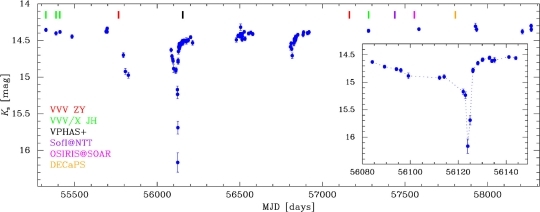
Image: Lightcurve of VVV-WIT-07 showing how it varied in brightness between 2010 and 2018. The insert shows an expanded view of the particularly dramatic dimming event that occurred in July 2012. Credit: Saito et al.
Is it possible we are looking at some kind of circumstellar disk with huge variations in it, a clumpy disk that blocks the star’s light in this highly irregular way? The odds on that seem long. Here is what the paper says:
Alternative scenarios for VVV-WIT-07 include a “dipper” T Tauri star with clumpy dust structures orbiting in the inner disk that transit our line of sight (e.g. Rodriguez et al. 2017), or even a long period, high-inclination X-ray binary. The deep, narrow eclipse delayed with respect to a broad and shallower dip is reminiscent of the morphology seen in high-inclination low-mass X-ray binaries (LMXB, e.g. Parmar et al. 1986; Baptista et al. 2002). However, LMXBs are restricted to orbital periods of less than a few days while high-mass x-ray binaries (HMXB) can be found at Porb up to hundreds of days (e.g. X1145-619 has Porb = 187.5 d, Watson et al. 1981). Moreover, in this scenario optical and IR spectra would be dominated by the mass-donor companion star, and should show rotationally-broadened hydrogen absorption lines at epochs of no mass ejection episodes, which is not the seen in the spectra of VVV-WIT-07.
So we have something that gives us echoes of Boyajian’s Star, and may also remind us of Mamajek’s Object (J1407), an interesting pre-main sequence K5 star with a ring system eclipsing it. Or something we haven’t yet identified, perhaps in the form of multiple objects, may be moving between us and the host star, even a dense family of comet-like objects. VIV-WIT-07 would be easy enough to explain if it were a binary, but the observations clearly rule that out.
VISTA has observed VIV-WIT-07 85 times already. Needless to say, it will be the subject of even more intense scrutiny. The paper also notes recent discoveries like OGLE LMC-ECL-11893, an eclipsing star consistent with a dense circumstellar dust disk structure, and PDS 110, an eclipsing system with likely transits by a companion with a circumstellar disc.
The paper is Saito et al., “VVV-WIT-07: another Boyajian’s star or a Mamajek’s object?” in process at Monthly Notices of the Royal Astronomical Society (preprint).






March 27, 2019
The Problem with Probes
I’ll wrap up this three-part series on ‘lurker’ probes and ways of finding them with Keith Cooper’s provocative take on the matter. A contributor to Centauri Dreams whose far-ranging ideas have fueled a number of dialogues here (see the archives), Keith is editor of Astronomy Now and the author of the upcoming book The Contact Paradox: Challenging Assumptions in the Search for Extraterrestrial Intelligence. I’ve read the manuscript and can tell you that you’re going to want this one on your shelves. Today, Keith takes us into the practical realm. If we were to find a Bracewell probe in our Solar System, what would we do with it? Who might discover it, who would claim its technologies, and what, under international law, would be its legal status? Plenty of material for science fiction plots here as we embark on the search to see what’s out there among Earth’s co-orbitals.
by Keith Cooper

It’s enough to keep me awake at night.
Suppose that an extraterrestrial probe is discovered in our Solar System, anchored to a co-orbiting near-Earth asteroid. It could potentially instigate one of the biggest crises in all of human history.
Consider this nightmare scenario: the alien probe would quite possibly be discovered by one of our probes. If we’re lucky, it will be one of our science missions, like Hayabusa2 or OSIRIS-REx. If we’re unlucky, it could be an autonomous asteroid-mining spacecraft, sent into space to chew up asteroids and refine their rocks for their precious minerals.
In that case, first contact could well end up with us destroying the alien probe along with the asteroid. Maybe the probe will defend itself and destroy the mining craft. Or, if the probe is passive, then maybe its last moments relayed back to its home civilisation will be of a human-built robot looming threateningly. Either way, it’s not the kind of first impression we’d really want to make.
Maybe that scenario is too far-fetched for you. Okay, let’s just go with the option of an alien probe being discovered during a science mission, or by an astronomical survey. We might try and contact it, but could we really resist the lure of advanced extraterrestrial technology just a few million kilometres from Earth? Of course not. Nations and private space companies will rush to try and capture the probe and to learn its secrets. Who, if anyone, would have the rights to claim it? It could lead to conflict between competitors, or maybe the probe would again try and defend itself, an act that we might deem to be hostile.
What we can learn from these scenarios, besides the importance of making a good first impression on behalf of humanity, is that there is a startling unpreparedness for any such discovery of a watching probe.
In his new paper (see A SETI Search of Earth’s Co-orbitals), Jim Benford has proposed searching asteroids in co-orbiting orbits – objects in a 1:1 gravitational resonance with Earth such that they orbit the Sun in exactly the same time as our planet, shadowing our world but on orbits that are a little more elliptical. Relative to Earth, these orbits trace out ‘horseshoe’- or ‘tadpole’-shaped paths. The co-orbiting objects include the asteroid Cruithne, which starred in Stephen Baxter’s novel Manifold: Time and gets as close as 12 million kilometres, and Earth’s first known Trojan asteroid, 2010 TK7, which comes as close as 19 million kilometres.
Benford recommends that Breakthrough Listen target these co-orbiting neighbours, since they would give an alien probe an ideal vantage point from which to watch us. It’s a great idea, and although I think there’s a very low probability of success, as with anything to do with SETI, we won’t know until we look. However, as per the scenarios above, the discovery of a probe could be fraught with danger.
If a probe is discovered, who has the right to claim its technology? In an ideal world I would say nobody, and that aside from trying to communicate with it, we should leave it be. However, we’re talking about human beings here, and the temptation to capture the probe and learn its secrets will be too hard to resist. But it could lead to one almighty free-for-all.
So I asked Frans von der Dunk, who is Professor of Space Law at the University of Nebraska-Lincoln, what the Outer Space Treaty says about extraterrestrial probes. Unsurprisingly, it doesn’t say anything. Instead, von der Dunk suggests that if we substitute ‘natural resources’ for ‘technology’ , then the best interpretation of the current law would be to treat the probe as any other celestial object, such as an asteroid, which can be mined or otherwise appropriated.
“In my view, [this] would indeed not make it illegal for states to unilaterally condone someone going for the technology and trying to appropriate it, if under an appropriate license and otherwise complying with whatever international space law dictates with respect to the use of outer space, as per Art. VI of the Outer Space Treaty,” he says.
However, von der Dunk accepts that rivals for the probe’s technology would be unlikely to accept this if it looks like someone else is going to get there first, leading to all kinds of diplomatic shenanigans, and potentially conflict.
There are other issues with the law. If the probe contains a sentient artificial intelligence, should it not be treated as a sentient being according to the law? The problem is, other species on Earth, such as dolphins, are also sentient but the law does not recognise them with the same rights as human beings.
Then there is the concern that the probe would defend itself against any action it deemed hostile. Given that we would not know its capabilities, nor the motivations of the civilisation that programmed it, this could be exceptionally risky on an existential scale. Should we destroy or capture the probe then we could incur the wrath of whoever sent it; if it defends itself, we cannot know what lengths it would go to before ceasing fire. There’s even a case for leaving the probe alone after discovery, and not attempting to communicate with it; the probe could be hibernating and unaware of our modern technological developments until we start poking and prodding it. As the saying goes, we might not want to wake the dragon. Visions of Fred Saberhagen’s berserker probes abound.
To be fair, I don’t necessarily agree with that assessment. If an alien probe is going to venture into our backyard, it would seem unreasonable to then not expect us to be curious. However, we do need to act accordingly, and sensibly. So far, little to no thought has been put into this. If we are going to embark on a search, as Benford encourages, then we need to start thinking about what the consequences will be and how we’ll manage them, and we need to start thinking about this with some haste. Should SETI discover a radio signal from another civilisation, it will have originated many light years away; sheer distance mitigates the danger. A probe, however, will be a cosmic stone’s throw from us, and any potential danger would be immediate.
So, this is what I recommend: any search must be in conjunction with educating space agencies and private space companies about the possibility, however small, of a probe being discovered. The asteroid mining companies of the future would especially have to bear this in mind, and survey their target asteroids thoroughly before mining, to make sure there are no probes there.
In the meantime, we should develop first contact protocols to be implemented if a probe is discovered, and we also need to update the law, such that if a probe is found, then it doesn’t result in a potentially violent mêlée as we race to learn its secrets before our rivals, and that whatever benefits can be gleaned from the probe are made available to the whole of humankind.
If we can meld the societal issues with the practical issues of the search, it would stand SETI in good stead. It would act as a precedent for that other area of controversy, the METI versus SETI debate, which revolves around the societal complications of instigating contact. And, if we could find and make contact with a probe, what a wonderful opportunity that would be, bypassing traditional SETI and providing instant contact. Since Jean-Luc Picard is only a fictional character, the question then becomes, who else should we nominate to speak to the probe on behalf of Earth?
But that’s a topic for another time.






March 26, 2019
Gregory Benford: Further Thoughts on ‘Lurkers’
Because I’ve been re-reading Gregory Benford’s Galactic Center sequence (now into Furious Gulf), I want to quickly mention the galactic center simulation available here, which offers a 360-degree, ultra-high-definition view based on Chandra X-ray observations as massaged by NASA supercomputers. It’s lively stuff, showing “the effects of dozens of massive stellar giants with fierce winds blowing off their surfaces in the region a few light years away from the supermassive black hole known as Sagittarius A* (Sgr A* for short).” Just remember Greg got there first. But back to the probe question we’ve been examining. Jim Benford’s take on a SETI search for ‘lurkers,’ probes that fit into the Bracewell category, examines targets known as Earth co-orbitals, as we saw on Friday. UCI physicist Greg Benford’s comments about his brother’s article examine the question of what the presence of such a probe in our system might imply. The possible scenarios take us into the realm of what Greg has called ‘deep time.’
by Gregory Benford

Consider time scales. Some tech society within a few hundred light years may have sent a Lurker which remains operating now. But our routine radio signals are only a bit more than a century old. If a Lurker reports back to its origin, it may well have not gotten an answer yet about how to proceed.
This means we should consider searches over decades-long time scales. In any case, we can carry out interrogations by radar and consider missions to orbit nearby targets and survey for Lurker sites, which may have gone dead in the distant past, or be intermittently active now.
We humans measure our eras in millennia at most. Within a century or so we may plausibly have made computer minds that could manage a Lurker that voyages for centuries and watches a biologically active world for more millennia still. If societies can persist for very long times, they will have alien artificial intelligences.
If ETI dispatches Lurkers here, these may report back any attempt at contact but do no more. Or Lurkers may be free to respond, if they were instructed so by their home society (or societies) earlier. Or further still, Lurkers from the far past may have done their duty and slowly failed, finally, into their own demise.
On scales of millennia, the ruins of Lurker installations, including mining for resources on nearby orbiting sites, may be visible, even though their animating intelligences are long gone. Surveying, exploring satellites could see these ruins and learn much from them. Thus a lack of response to our pings and messages may simply imply a needed further study through exploring probes.
This implies a staging of research. At each level, we disprove a hypothesis. Moving on in this way will disallow models of alien societies ranging through ever-larger distances, and ever longer past eras. This program can go forward for decades, as our capabilities grow. Our understanding of the near-orbital objects will grow as well, giving us a gamut of possibilities we can imagine and then test.
These minds must be made for social species; otherwise it seems unlikely that loner species like our carnivores will care much for speaking to distant others, a point made by E.O. Wilson. As Wittgenstein said, “If a lion could speak, we could not understand him.”
Translation would be unlikely if an ET mind were a single integrated intelligence, without social species drives; yet a Lurker may well be that. As well, a Lurker may be thrifty in energy use. If it came here using a nuclear drive or energy source, it would have to mine for radioactives to keep itself running—or erect large solar panels. (This is another reason to lurk near Earth: higher solar flux.) It may well be an occasional watchman, not continuous. Or it may have a small alert system to summon the larger intelligence when certain events or symptoms occur—such as a hail from Earth that repeats and contains self-explaining images that convey interest, such as a picture of the Lurker itself seen from afar. All these possibilities speak for a repeating observation and hailing pattern. This should be a long game, over years at least.






March 22, 2019
A SETI Search of Earth’s Co-orbitals
One objection to SETI is that it is not falsifiable — there is no point at which a lack of signals can prove that extraterrestrial civilizations do not exist. But there are some aspects of SETI that can be falsifiable. Consider a class of objects near enough for us to investigate not only with listening efforts but with probes, one small enough to be thoroughly covered, and one most people know almost nothing about. Could these offer a listening post for ‘Bracewell probes,’ a way of watching the development of our culture and reporting home to ETI? And if so, could we combine SETI with METI to advance both disciplines without compromising our own security?

If the idea of nearby probes seems far-fetched today, it was even more so when Ronald Bracewell advanced his ‘sentinel hypothesis.’ Bracewell took the question of SETI and stood it on its ear. That was no mean feat in 1960, for SETI was just being born in that year through the efforts of Frank Drake at the Green Bank instrument in West Virginia. While Drake was, reasonably enough, asking whether we might pick up signs of an extraterrestrial civilization around another star, Bracewell had begun to wonder whether there might be a different way to study an alien culture. A long-lived probe could be planted in any system under investigation.
Image: Stanford’s Ronald Bracewell, who in 1960 advanced the idea of long-lived probes investigating other planetary systems. Credit: Stanford University.
Add Von Neumann-style self repair and such an object might stay on sentry duty for millennia, for aeons, all the while returning useful data about the changes occurring on an interesting habitable planet. And if a civilization arose on that planet and reached the level of electromagnetic communications, then the probe could be programmed to make contact, at whatever threshold its builders chose.

Jim Benford has been thinking about Bracewell probes and their possibilities of late because they offer advantages over traditional forms of SETI. For one thing — and this is a huge advantage — a contact once made with a local probe could initiate dialog in more or less real time, without interstellar lightspeed delays, although of course we would be querying an intelligence that was itself subject to those delays if it communicated with its home world.
Image: Plasma physicist Jim Benford (Microwave Sciences).
The question is interesting enough that is has inspired some top-notch science fiction, in particular David Brin’s novel Existence, where the idea is extended to not one but a series of different probes at work in Earth orbit and in the asteroids. But it would be Michael Papagiannis who in 1978 wrote seriously about the asteroid belt as a possible venue for such ‘lurkers,’ (to use Benford’s term). Benford is not sold on the asteroid belt as a target.
For we also have an all but undiscussed body of targets that can be called co-orbital objects with Earth. These small objects approach the Earth closely and on an annual basis, for they have the same orbital period as Earth. We might study them for signs of artificiality through spectroscopy in the visible or near-infrared as well as pinging them with radar or other signals.
What strange orbits these objects occupy, with some in so-called ‘horseshoe’ orbits — these can actually become quasi-satellites for a time before returning to earlier orbital parameters. Have a look at a horseshoe orbit.
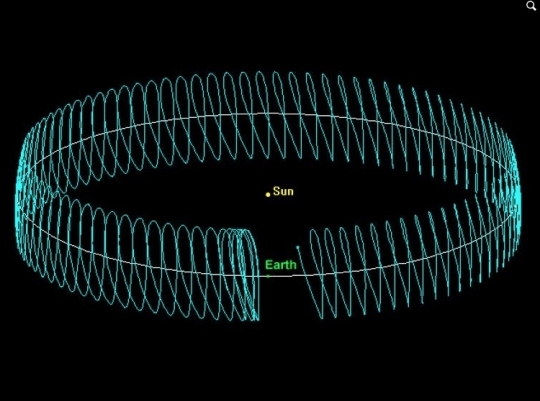
Image: A horseshoe orbit. No wonder these objects took so long to find. Credit: James Benford.
And from another view:

Image: Plan showing possible orbits along gravitational contours. In this image, the Earth (and the whole image with it) is rotating counterclockwise around the Sun. Credit: Wikimedia Commons.
As Benford explains, think of a quasi-satellite as an object in a 1:1 orbital resonance with a planet, so that the object stays close to the planet over many orbital periods. Outside the Hill sphere (that region where an astronomical body dominates the attraction of satellites), quasi-satellites cannot be considered true satellites. Instead, while their period around the Sun is the same as the planet, they seem to travel in an oblong retrograde loop around it.
Beyond horseshoe orbits we also find ‘tadpole’ and ‘quasi-satellite’ orbits as shown in the figure below. Here we find stable orbits for centuries and possibly longer, much longer. Co-orbitals include Cruithne (3753), a 5-kilometer object with closest approach to Earth of 0.080 AU — interestingly, this one experienced a close encounter with Mars in historical timescales, around the time of Periclean Athens. Another is Earth Trojan 2010 TK7, which oscillates around the Sun-Earth Lagrangian point L4, and 2016 HO3, which Benford describes as “currently the smallest, closest, and most stable (known) quasi-satellite of Earth,” with a minimum distance of 0.0348 AU. A number of other quasi-satellites are known.
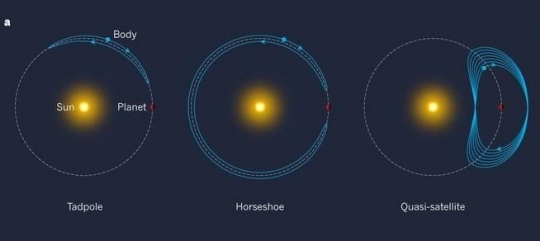
Image: Three types of co-orbital orbits. Credit: James Benford.
How might we investigate these objects with the tools of SETI, and why? Benford calls for a multi-year program of observations in radio and optical wavelengths as well as planetary radars, with the main burden of the work falling upon the Lick Observatory and other platforms involved in the Breakthrough Listen project. Here we’re looking for size, shape, rotation periods and spectra. At the same time, he urges SETI observations of this range of objects.
Planetary radar also comes into play, and with an interesting consequence. From the paper:
These objects have not been pinged or imaged by any planetary radar as yet. Recent developments in planetary radars have shown they can detect the presence and trajectories of spacecraft in lunar orbit, even though their size is a few meters. Whether these radars are sensitive or powerful enough to get a return signal from any of the presently known co-orbital objects requires analysis. In any case, they can ‘ping’ the objects, meaning that a signal reaches there but the return signal may be too weak to detect at Earth.
Here the Bracewell idea comes into full view:
If there is an ET probe there, it might sense that it had been noticed by us.
What an interesting campaign Benford has in mind. It includes simultaneous use of planetary radar on the target and SETI observations. Readers at this point may be recalling that Benford is on the record with strenuous objections to METI, the idea of Messaging to Extraterrestrial Civilizations, given the limits on what we know about what is around us in the cosmos, and the need for international agreement on how to proceed, as opposed to sending signals to the stars in random bursts of activity and with wildly varying content.
Yet here we are talking about an activity that, in the unlikely event there is a probe in our own Solar System, could conceivably activate it and cause it to respond. The Bracewell probe is front and center here, recalling Duncan Lunan’s 1974 proposition that a Bracewell probe could be the cause of long-delayed echoes of radio transmissions heard in the 1920s. Benford notes that the phenomena Lunan identified have subsequently been explained as unusual propagation patterns in Earth’s magnetosphere. But it’s interesting to see Benford’s response to the idea of METI in this new context:
This would be ‘Active SETI’, which could solicit a response from a hypothetical probe. This does not incur the objections to sending interstellar messages, messaging to ETI (METI), because any such alien lurkers would already know we are here. Of course, this is at very short range compared to the interstellar ambitions of METI enthusiasts. We presume that Lurkers already know that we have radar, but might not respond to a single radar painting such as we have done to many asteroids. If we want to send a message, as Paul Davies suggested for the LaGrange points in 2010, how would a signal be designed to elicit such a response?
An interesting question indeed, and as the author points out, actually working on a near-term use of METI at a nearby target could benefit research into message creation and drive the field forward. The problem is an easy one to state: What kind of message would one send to a lurking probe that would ‘awaken’ it to the possibility of communicating with us?
As to falsification and SETI:
In my view SETI has suffered from being seen as somewhat nonscientific. That’s because it doesn’t offer itself as a study with falsifiable propositions, which is the very definition of science, as Popper said.
I advance a falsifiable proposition: “There exist in near-Earth space extraterrestrial probes which are observing Earth and it may be possible for us to find and contact them.
This proposition can be disproved. We can observe them, ping them with radar, transmit messages to them, send robotic probes to them and visit them with human spacecraft missions.
What a lively concept. We blend SETI’s listening to the stars with astronomical imaging and spectroscopy, while simultaneously turning METI into what Benford calls a ‘local experiment.’ And as we do this, our efforts at studying co-orbital objects advance the cause of astronomical science, which is engaged in the great process of mapping the entire Solar System.
The paper is Benford, “Looking for Lurkers: Objects Co-orbital with Earth as SETI Observables,” submitted to the Astrophysical Journal. I’ll have a link to the preprint as soon as it goes live.






Paul Gilster's Blog
- Paul Gilster's profile
- 7 followers



